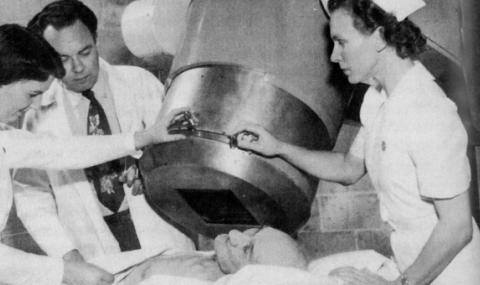Procedure: Removal of Peripheral Arterial Line
Ensure that patient and health care provider safety standards are met during this procedure including: - Risk assessment and appropriate PPE
- 4 Moments of Hand Hygiene
- Procedural Safety Pause is performed
- Two patient identification
- Safe patient handling practices
- Biomedical waste disposal policies
|
Equipment Needed:
- Sterile tray with suture removal scissors.
- Chlorhexidine 2% and 70% alcohol swabs.
- 2 - 4X4 sterile gauze squares.
- Transparent occlusive dressing.
- Non-sterile gloves
- Sterile gloves
- Bedside stool (if required).
PROCEDURE FOR REMOVAL OF A PERIPHERAL ARTERIAL LINE | - Apply Related Procedures and Policies
- Check Coagulation Tests
- Prepare Bedside
- Prepare Tray
- Remove Dressing
- Cleanse Site and Remove Suture
- Remove Catheter
- Ensure Hemostasis
- Apply Occlusive Dressing
- Post Removal Assessment
- Document
| PROCEDURE | 1. | Apply Related Procedures and Policies Do not clamp of a vascular device in anticipation of removal. This will not reduce bleeding from the site but may lead to thrombosis/embolus to the distal extremity. | 2. | Check Coagulation Tests/Medications Check INR/PTT and platelets. If INR/PTT is prolonged (INR > 1.5) or platelets < 50,000 review orders with physician. If patient is receiving any medications that affect coagulation (e.g., anticoagulants, fibrinolytics, antiplatelet agents), review with physician prior to removal. To reduce risk for bleeding. If the patient has a significant coagulopathy the removal order should be reviewed to determine whether treatment is warranted (e.g. administration of plasma or platelets) or whether removal should be delayed. Medications that interfere with clotting should also be reviewed. The catheter site may also influence bleeding risk. Additional site pressure may be required | 3. | Prepare Bedside and Assess Patient Administer analgesic and sedative (if indicated). | | 4. | Prepare Tray Perform hand hygiene and open central line dressing change tray. Don non-sterile gloves and mask with face shield. Perform hand hygiene and prepare dressing tray aseptically using transfer forceps to add supplies. Add sterile scissors or additional chlorhexidine for removal of securement device. Add sterile 4 X 4 gauze and occlusive dressing to tray. | 5. | Remove Dressing Remove dressing. Discard dressing appropriately and perform hand hygiene. | 6. | Cleanse Site Don sterile gloves and cleanse site. Wait until chlorhexidine has completely dried. Remove sutures if present. To remove an adhesive securement device, use a chlorhexidine and/or alcohol based swabstick to "shovel" under the dressing from edge to centre until released from the skin. | 7. | Remove Catheter Position gauze over insertion site and gently withdraw catheter slightly to ensure that catheter will withdraw easily. Pull the catheter in a slow but steady withdrawal motion, applying immediate and directly pressure slightly above the insertion site upon removal Inspect catheter for intactness. Notify physician Immediately if catheter is damaged. Send tip for culture if ordered. EMERGENCY RESPONSE Catheter Breakage: Apply direct pressure above the puncture site to occlude blood flow. Position patient on left side with head down (Trendelenburg position) and notify physician STAT. If catheter fracture is palpable, apply additional pressure to prevent catheter migration. | 8. | Ensure Hemostasis Hold direct pressure firmly and continuously for a minimum of 5 minutes BEYOND the point when hemostasis has been achieved. Carefully check site and distal circulation every 5 minutes and reapply pressure for 5 more minutes if oozing is observed. Adequate and direct pressure is required to stop bleeding from a central venous or arterial catheter. The only way to stop bleeding and ensure occlusion of catheter tract is through direct pressure until hemostasis is achieved. Inadequate hemostasis can facilitate hematoma formation with subsequent vessel occlusion, limb ischemia or fistula formation. | 9. | Apply Occlusive Dressing When bleeding has stopped completely, apply a transparent dressing or bandaid to the site. Do not apply pressure dressings or sandbag to site. Direct pressure is required until bleeding has stopped. The occlusive dressing allows visualization of site while preventing pathogens from entering tract. Pressure dressings and sandbags will not stop a vascular bleed but will delay detection of bleeding. Inadequate pressure can result in hemorrhage or hematoma. | | 10. | Post Removal Assessment Minimize limb movement for at least one hour post removal. Ensure limb site is visible in order to promptly detect bleeding. Monitor for hematoma or bleeding q 5 minutes X 30 minutes, then q 30 minutes X 2 then q 1 h X 4. Reapply pressure if bleeding present. Assess distal extremity and monitor for decreased circulation, change in limb color or delay in capillary refill q 5 minutes X 30 minutes, then q 30 minutes X 2 then q 1 h X 4. . | | 11. | Document Document removal and catheter assessment (intact) in the Device section of the EHR. Document assessment of site and CCM at time pressure is released, 15 minutes later, then Q 30 minutes X 2, then Q 1 H X 4. Document abnormal findings in the assess/reassess section and notify provider. Update "date and time removed" in the Actions and Situational Awareness section in Nurse View of the EHR, and communicate recent removal during shift-to-shift report. Include this information in the documented Transfer of Accountability. | | |
|
References: 1. O'Dowd, L. et al. (October 2013). Air embolism. Up-to-Date. 2. LHSC Procedure for Central Line Management. 2. Kaye, W. (1985). Venous and arterial catheterization. In Sprung, C., and Grenvik, A. Eds: Invasive procedures in critical care. Churchill Livingston: New York p. 13. 3. Daily, E., and Schroeder, J. (1994). Techniques in Bedside Hemodynamic Monitoring (5th Ed.). Mosby: Toronto. p. 71.
Last reviewed: January 17, 2025
Brenda Morgan CNS, CCTC |



